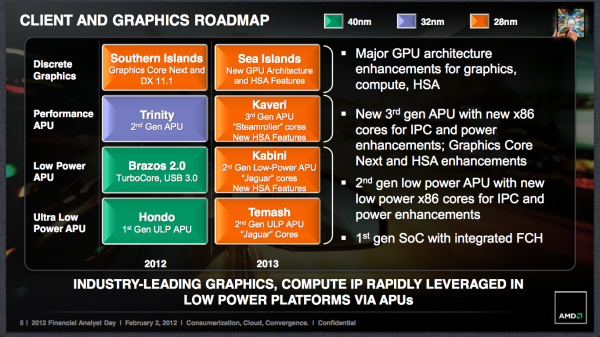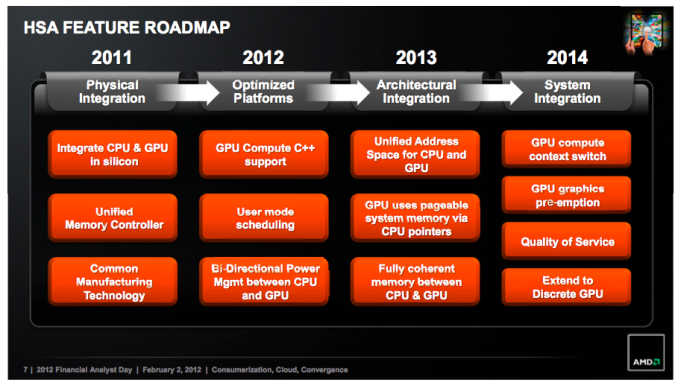AMD Radeon HD 7790 Review Feat. Sapphire: The First Desktop Sea Islands
by Ryan Smith on March 22, 2013 12:01 AM EST- Posted in
- GPUs
- AMD
- Sapphire
- GCN
- Radeon HD 7000
Bonaire’s Microarchitecture - What We’re Calling GCN 1.1
With our introduction out of the way, before looking at the cards and our performance results we would like to dive into a technical discussion and a bit of nitpicking. Specifically we would like to spend some time talking about architectures and product naming, as it’s going to be a bit confusing at first. As AMD has stated numerous times in the past, Graphics Core Next is a long-term architecture for the company. AMD intends to evolve GCN over the years, releasing multiple microarchitectures based on GCN that improve the architecture and add features while still being rooted in the design principles of GCN. GCN is after all the other half of AMD’s upcoming HSA-capable APUs, the culmination of years of AMD’s efforts with HSA/Fusion.
So where does Bonaire fit in? Bonaire is of course a GCN part; it’s a new microarchitecture that’s technically different from Southern Islands, but on the whole it’s a microarchitecture that’s extremely close in design to Southern Islands. In this new microarchitecture there are some changes – among other things the new microarchitecture implements some new instructions that will be useful for HSA, support for a larger number of compute work queues (also good for HSA) and it also implements a new version of AMD’s PowerTune technology (which we’ll get to in a bit) – but otherwise the differences from Southern Islands are very few. There are no notable changes in shader/CU efficiency, ROP efficiency, graphics features, etc. Unless you’re writing compute code for AMD GPUs, from what we know about this microarchitecture it’s likely you’d never notice a difference.
Unfortunately AMD has chosen to more-or-less gloss over the microarchitectural differences altogether, which is not wholly surprising since they will be selling Bonaire and previous generation products side-by-side. Bonaire’s microarchitecture has no official name (at least not one AMD wants to give us) and no version number. The Sea Islands name we’ve been seeing thrown around is not the microarchitecture name. Sea Islands is in fact the name for all of the GPUs in this wave – or perhaps it would be better to say all of the products created in this development cycle – including both Bonaire and it’s new microarchitecture, and Oland, AMD’s other new GPU primarily for mobile that is purely Southern Islands in microarchitecture.

In fact if not for the fact that AMD released (and then retracted) an ISA document called “AMD Sea Islands Instruction Set Architecture” last month, we would likely know even less about Bonaire’s microarchitecture. The document has been retracted at least in part due to the name (since AMD will not be calling the microarchitecture Sea Islands after all), so as a whole AMD isn’t particularly keen in talking about their microarchitecture at this time. But at the same time from a product standpoint it gives you an idea of how AMD is intending to smoothly offer both Southern Islands and Bonaire microarchitecture parts together as one product family.
Anyhow, for the sake of our sanity and for our discussions, in lieu of an official name from AMD we’re going to be retroactively renaming AMD’s GCN microarchitectures in order to quickly tell them apart. For the rest of this article and in future articles we will be referring to Southern Islands as GCN 1.0, while Bonaire’s microarchitecture will be GCN 1.1, to reflect the small changes between it and the first rendition of GCN.
Ultimately the differences between GCN 1.0 and GCN 1.1 are extremely minor, but they are real. But despite our general annoyance in how this has been handled, for consumers the difference between a GCN 1.0 card like the 7770 and a GCN 1.1 card like the 7790 should be limited to their innate performance differences, and of course PowerTune. GCN 1.1 or not, Bonaire fits in nicely in AMD’s current product stack and is in a position where it’s reasonable for it to be lumped together with GCN 1.0 parts as a single family. It’s really only the technical enthusiasts (like ourselves) and programmers that should have any significant reason to care about GCN 1.0 versus GCN 1.1. For everyone else this may just as well be another Southern Islands part.











107 Comments
View All Comments
ThomasS31 - Friday, March 22, 2013 - link
I dont think this is the Sea Island generation yet...Ryan Smith - Friday, March 22, 2013 - link
This is Sea Islands. Oland and Bonaire are both part of the Sea Island family.CeriseCogburn - Sunday, March 24, 2013 - link
Bonaire sounds (like Bel Air) all stuffy and prim and proper - too bad amd fanboys aren't classy.At least it's not pitcairn, the in the pit card.
KnightRAF - Monday, March 25, 2013 - link
Congratulations Cerise, between this article and the HTC One article you have succeeded in injecting so much pointless crap that it is no longer worth the effort to sift your crap out to read the actual comments on the article.extide - Friday, March 22, 2013 - link
PLEASE!!! Add folding@home benchmarks to your tests, please please!!Thank You!
JarredWalton - Friday, March 22, 2013 - link
Might want to read a little better before posting:http://www.anandtech.com/show/6837/14
extide - Tuesday, March 26, 2013 - link
Sorry, doh, I feel dumb. I quickly scanned the compute page and didn't see it. Thank you VERY MUCH for including these!!MrSpadge - Friday, March 22, 2013 - link
It's good to see clock & voltage states become more fine-grained and their choice smarter. Ultimately how I'd like a GPU to work: set targets and limits for power use, temperature and noise.. and then crank it up as far as it goes. Vary chips by different amounts of execution units, not frequencies.This includes simple user settings for lowering power consumption (call it the "green mode" of whatever), if people want to, which would automatically choose lower voltages to increase efficiency.
And of course something similar to nVidias frame rate target: if performance if fine now, save power. And save some thermal headroom in case it's needed soon. Make smart use of the power budget. It's nice to see AMD making some progress!
Termie - Friday, March 22, 2013 - link
Ryan, just FYI, you're using Catalyst 13.2 beta 7 with the other cards, not Catalyst 13.7 betas as indicated in the text on "The Test" page.Ryan Smith - Friday, March 22, 2013 - link
Whoops. Thanks.